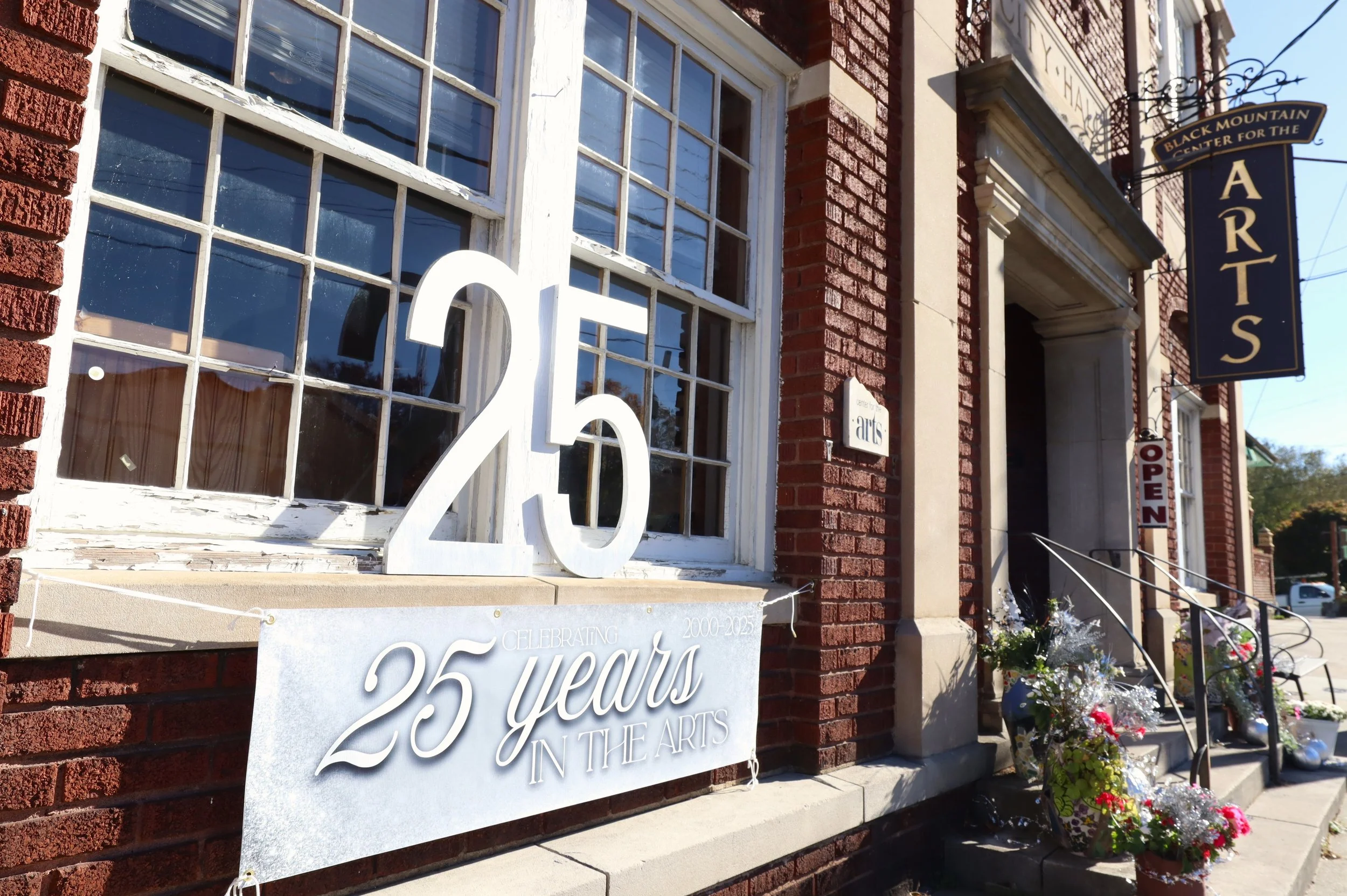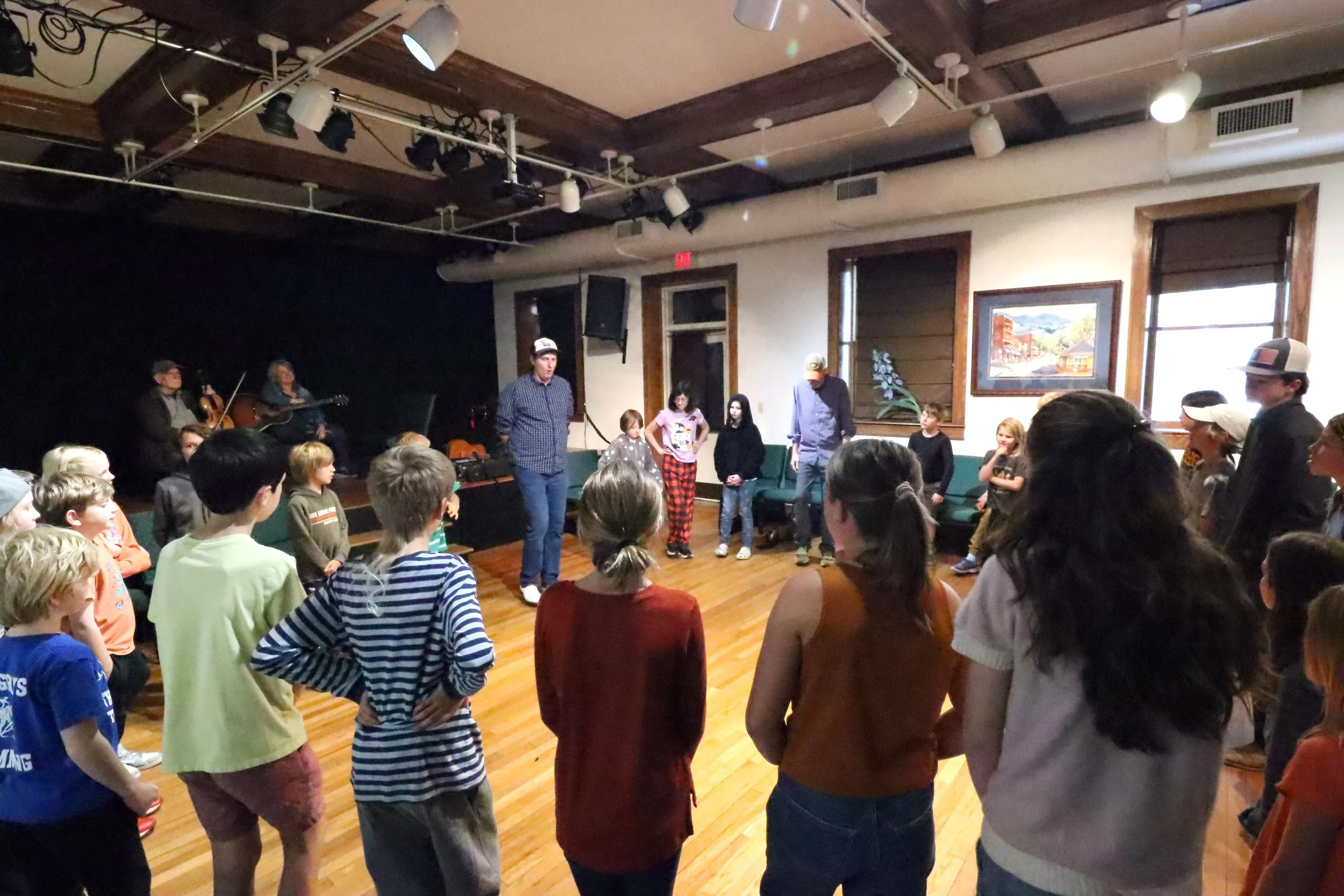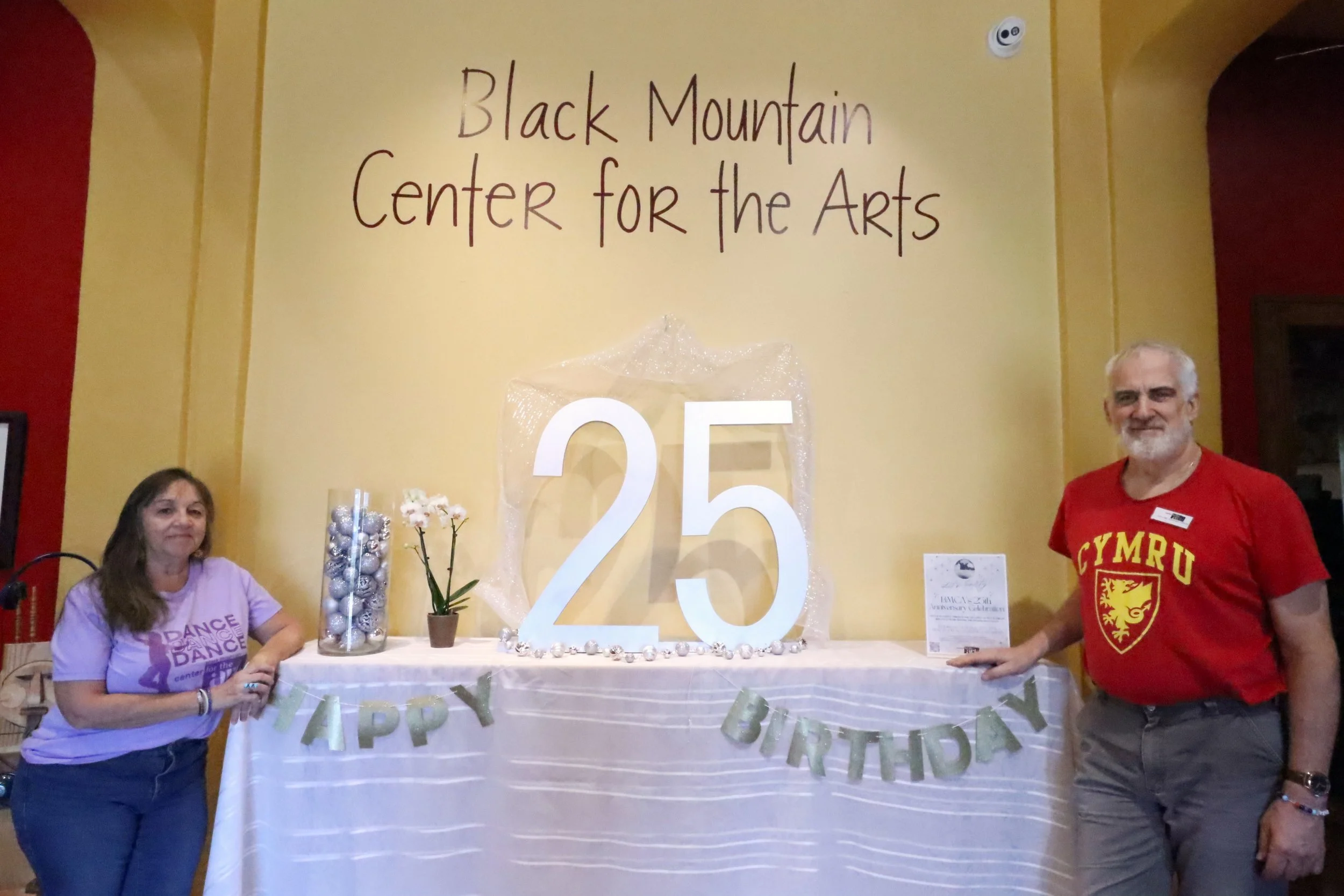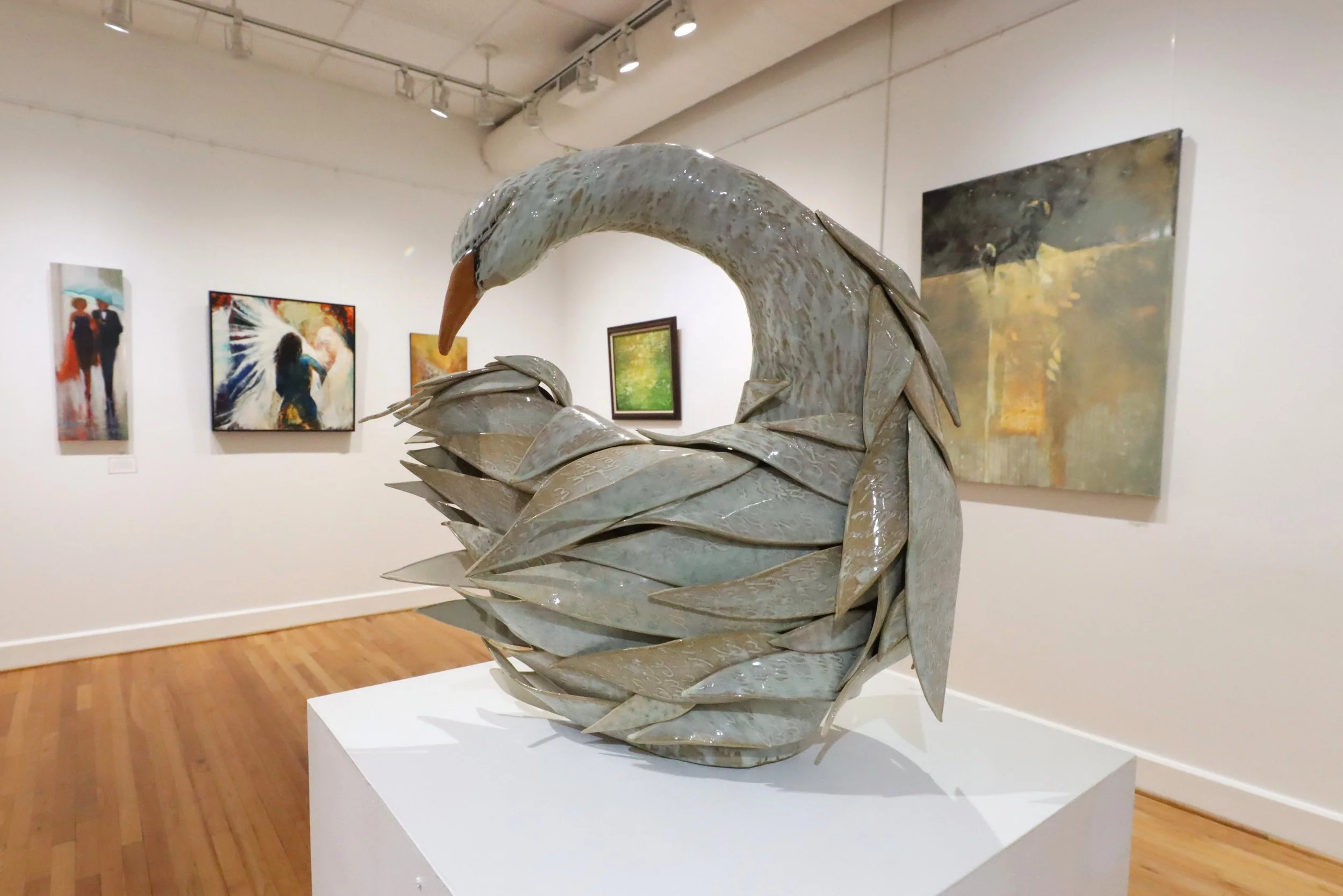Black Mountain Center for Arts shines while commemorating 25 years of creativity and community
Local nonprofit organization to celebrate silver anniversary with a ‘Dance Through the Decades’
Fred McCormick
The Valley Echo
October 24, 2025
The Black Mountain Center for the Arts will celebrate its 25th year, Oct. 25, when the nonprofit organization hosts a “Dance Through the Decades” party, featuring music by DJ Jamie Munn. Photo by Fred McCormick
Depending upon the era in which one visited downtown Black Mountain, the brick structure on 225 West State Street, built in 1927, would have offered distinctly contrasting atmospheres. Throughout most of the 20th century, it served as town hall in the middle of a burgeoning business district, housing local elected leaders, municipal offices, the Black Mountain Police Department and a two-bed jail cell.
By 1990, following the relocation of town offices to the east side of town, the ornate structure sat vacant for years, when a grassroots effort by local residents imagined a new and creative future for the prominent space. That vision became a reality in October of 2000, when the Black Mountain Center for the Arts opened its doors to the community and embarked on its mission to “bring arts to the people and people to the arts.”
As the downtown nonprofit organization celebrates its silver anniversary, beginning at 7 p.m., Saturday, Oct. 25, the historic building will be transformed into a festive setting that welcomes the community to “Dance Through the Decades,” with music from DJ Jamie Munn. Tickets to the event are available at blackmountainarts.org, with prices ranging from $25 for BMCA members and $30 for non-members.
BMCA Then…
Long before 225 West State Street was home to the Black Mountain Center for the Arts, the historic brick structure (right) was home to town hall, the police station, a courtroom and the first local library. Photo courtesy of BMCA
The brick structure, a contributing building within the downtown Black Mountain district on the National Register of Historic Places, was initially a multi-purpose property that held the local library on the top level, a small courtroom and eventually what is now the Black Mountain Swannanoa Chamber of Commerce. The current BMCA Clay Studio, launched in 2008, operated as the town garage.
Betty Tyson purchased the building to prevent its demolition in 1995. She was joined by a group that included Gay Currie Fox, Billy Edd Wheeler, Wendy Craig and other prominent civic leaders, in their efforts to establish a nonprofit organization capable of supporting the growth of the local art community. The campaign raised funds from area residents and procured grants to hire engineers and architects for the massive project.
Transforming the long-vacant facility into a nonprofit arts center for the new millennium was no small task, according to Gale Jackson, who led the BMCA from its launch until her retirement in 2019. The longtime executive director moved to Black Mountain with her late husband, known to many local residents as “Preacher,” from their home in Indiana to take the helm of the fledgling organization.
She was quickly captivated by the small town charm of the place in which she continues to reside, after learning about the position in a magazine advertisement. When they arrived, the Jacksons were greeted by then-mayor Will Kennedy, who passed away in 2006.
“Talk about a scholar and a gentlemen; he was amazing. The first interview was at his house,” Jackson recalled. “They were really respectful and considerate of my husband, because he was with me, even though he wasn’t part of the interview. Then, they had a big potluck dinner at another house and the entire board came.”
While Jackson was introduced to a “half-empty” downtown Black Mountain in February, she accepted the position and was back in town by April. Demolition on parts of the old building were soon underway, and the project would not be easy. As work continued, she set up a temporary office in the building now home to The Hop Handcrafted Ice Cream.
JAM, a program offered by BMCA to students ages 8 through 17, gathers in the Gale Jackson Theatre, Oct. 22, for a weekly class focused on traditional mountain music. Photo by Fred McCormick
“The BMCA building was a big undertaking because it had been empty for a long time,” said Jackson, who came to the position with a background in architecture. “It had all these things — a police station, library, Western Union — and even the firemen slept there. Now, all those things were gone, and it had been sitting there for a while. And, the jail was on the bottom floor, which was pretty interesting.”
The old garage in the back was in shambles, filled with vehicle parts, oil stains and only partially obscured by mangled bay doors An addition on the rear of the structure was in disrepair and torn down to make room for balconies, stairs and care was taken to preserve the historic appearance of the interior. The old town council chamber became what was dedicated in 2018 as the Gale Jackson Theatre and the former town library was transformed into the BMCA Upper Gallery.
When it opened its doors with a four-day festival that fall, the BMCA celebrated with “all kinds of things, everywhere,” according to Jackson.
“We officially opened on Oct. 19, and we had a big dance that weekend,” she said. “That was our first big fall festival, so people painted pumpkins and we brought in a theatre troop, which performed in front of a bunch of hay bales we brought into the back area for seating.”
Local musicians played shows and the community turnout was strong, launching the BMCA with a swell of community support. As new opportunities became available, Jackson intentionally sought programs that would help preserve the heritage and traditions of the local culture. She partnered with other nonprofit organizations in Madison and Yancey Counties to write a grant to the Blue Ridge National Heritage Area, which is dedicated to preserving the natural and cultural heritage of the region.
The funding awarded through the program supports Junior Appalachian Musicians (JAM), which teaches students, ages 8 through 17, traditional mountain music, incorporating the fiddle, banjo and guitar. That program remains one of the most popular offered through the BMCA, with a waitlist for registration.
Community support for the BMCA continued to create new opportunities. In 2008, Jeoff Bird offered to clean out the old garage in exchange for utilizing the space for his craft. He removed long-abandoned parts and established a safe area to offer limited pottery classes.
…and Now
BMCA executive director Lori Cozzi and associate director John Hall prepare for the “Dance Through the Decades” party, Oct. 25, when the local nonprofit organization will celebrate its 25th anniversary. Photo by Fred McCormick
Today, the Clay Studio behind the BMCA is home to one of many popular programs, offering ongoing classes for all ages and experience levels and private or group lessons. Open studio times are available daily in a structure that hardly resembles its mechanical roots.
The studio holds some of the many thriving art program Lori Cozzi inherited in 2019, when she was named Jackson’s successor and the second director in the history of the center. Cozzi, who led ArtSpace Charter School in Swannanoa for 13 years before her tenure with the BMCA, faced challenges far different than those experienced by the founders of the institution.
Six months into what she describes as her “dream job,” a worldwide pandemic temporarily stalled programs and interrupted momentum for countless nonprofit organizations around the world. That experience caused the BMCA, which employs a small but dedicated team of staff, including associate director John Hall, program coordinator Claire K. Landis, Clay Studio Manager Charles Feeland and office manager Michelle Migyanka, to find new ways to fulfill its mission.
“We try to be, first and foremost, a community arts center, offering a variety of things the community wants, or has expressed interest in,” Cozzi said. “We’re really focused on offering a variety of programming for all ages, so we’ve been really intentional on expanding programming to involve families and younger community members. Our youngest students here now are toddlers, in our our weekly music together class, and we have folks taking classes here who are well into their 90s.”
Efforts to reach a broader range of local citizens include the addition of MoveAbility classes, which welcome physically and intellectually disabled individuals ages 5 years old and up to explore movement and self-expression through dance. The program is offered for free or on a pay-as-you-can basis.
Traditional dance classes for youth and adults have been a mainstay of BMCA for years, while music lessons focusing on the Celtic harp, bass, folk guitar and banjo and singing round out a robust lineup. Access to instruction on the visual arts, with drawing and painting instructions from Bob Travers, are available for beginners or advanced artists, and the Swannanoa Valley Community Chorus, directed by Cary Fridley, welcomes “anyone who loves to sing.”
In recent years an online artist member directory, containing contact information and links to works of nearly 30 local creators, was established to promote genres ranging from mixed media, to acrylic, to watercolor and photography.
“We want to bring art into as many lives as we can,” Cozzi said. “So, we’ve also spent time looking at who isn’t coming, why they aren’t, and if they can’t afford to, we’re writing grants to make programs as accessible as possible. This is all part of working to keep this valuable resource in our town.”
While the BMCA began as a central location supporting area artists, the evolution of the local arts community has included opportunities to strengthen its partnerships with other local nonprofits.
“We’re really connected to other arts organizations in the area, and there has been a lot of synergy with that over the last few years,” Cozzi said. “We work with Red House Gallery, regularly, and I’m on the board over there. We’re also really excited about the N.C. Glass Center and we are cooking up some dates to have some of our gallery openings align, so we can get more people to Black Mountain for those events.”
A silver celebration
The “Shine On BMCA’s 25th Anniversary Exhibition,” displayed in the Upper Gallery through Oct. 31, features work from invited legacy artists who have played significant roles in the growth of the nonprofit arts center. Photo by Fred McCormick
The “Shine On BMCA’s 25th Anniversary Exhibition,” on display through Friday, Oct. 31, in the Upper Gallery of the BMCA, features the work of community artists and invited BMCA legacy artists.
“It has a theme of illumination, light, metallics, and you can see a little bit of everything up there,” Cozzi said. “That exhibit celebrates what that gallery has been and where it’s going. We have a few artists featured, like Libba Tracy and Julia Burr, who have played impactful roles in our history.”
In recent years, that history has included the addition of a pair of prominent murals downtown, with “Community,” installed on the western facing wall of the building by Brushcan Murals in 2019. “Beautiful Migration,” which consists of two murals, was added to the back of the structure in 2022. “Mighty Migrants,” depicting monarch butterflies and milkweed is a tribute to Anni Albers, while “Universal Citizen,” offers an artistic interpretation of Ruth Asawa sitting with her work, greeting visitors who arrive at the back entrance.
Both pieces, supported by the N.C. Arts Council, were painted by Lara Nguyen, a former Warren Wilson College art professor who passed away in 2023.
The public art projects are among the many community-inspired projects that have brought new people to the BMCA for more than two decades. Some of that wide-ranging appeal is rooted in the construction of a stage in the theatre, where locally themed performances began bringing crowds to the intimate space.
“Way Back When,” a series based on traditional folk tales from the Swannanoa Valley, ran there for seven years, often producing sold-out shows.
“I hired Rebecca Williams and Jerry Pope to collect oral interviews, and we hosted story circles through a partnership with the Swannanoa Valley Museum,” Jackson said. “One of the most helpful was Wayne Martin from Swannanoa. The idea was we collected these stories and legends and created folk plays, which turned into a musical because we partnered with Bert Brown.”
The productions featured Brown’s original music and preserved tales originating from Cherokee lore and continuing through the era of newly American settlers.
“They were just perfect songs, and they fit so well into the entire thing,” Jackson said. “That entire series is something that I’m particularly proud of, because it truly brought the community together. The stories celebrated the history and legacy, while giving newcomers a deeper understanding and feeling of what was here.”
Blending that rich history with the present was a key element in the planning of the anniversary celebration, according to the current BMCA director.
“I brought together some of the players from our past, including Gale, Rita Vermillion, Jessica Klarp and Diane Hutchins to help plan the event,” Cozzi said. “These are all significant figures in our past and we decided this is a party, so there should be dancing. We also wanted an opportunity for people to look at our history, so we have some article clippings and artifacts from our past displayed around the building.”
The celebration will also include an ice cream sundae and make-your-own snack mix bars. A memory photo booth will also be available to commemorate the occasion. Marking 25 years of a grassroots initiative to provide a platform for local artists is something the entire community can be proud of, according to Cozzi.
“It’s very unique for a town our size to have an arts center like this, and that’s something we’re both proud of and grateful for,” she said. “I think all the time about those early people, like Betty Tyson and Gay Currie Fox, who worked so hard and did so much to get the center open. Their vision was an extraordinary gift to give to this community, and we’re honored to be able to celebrate it.”





